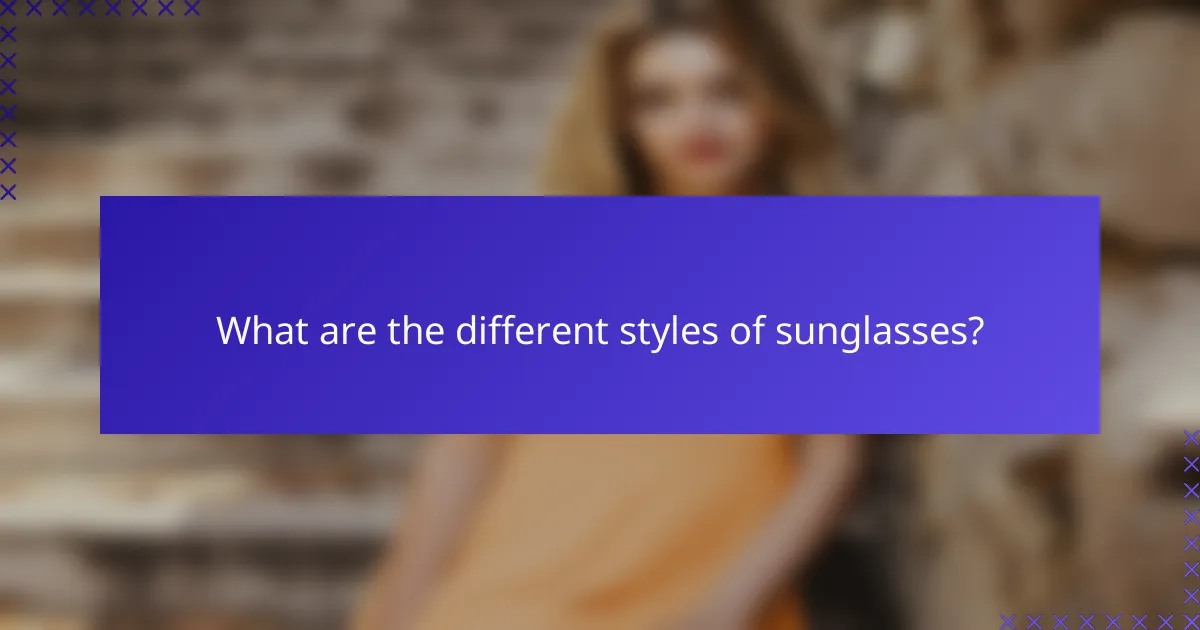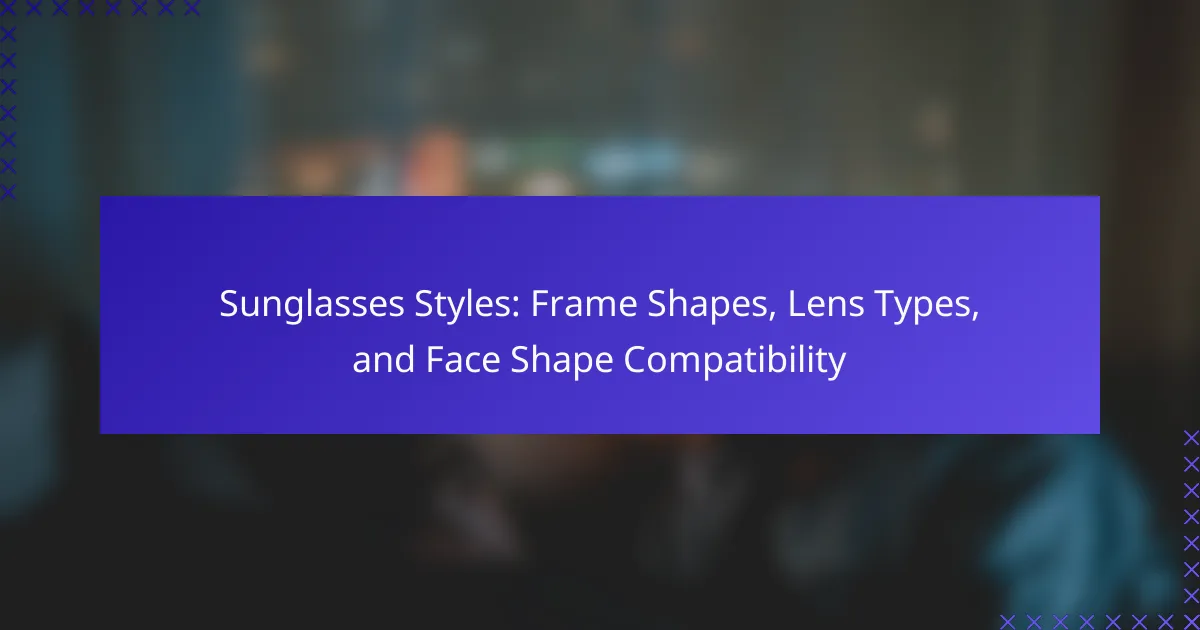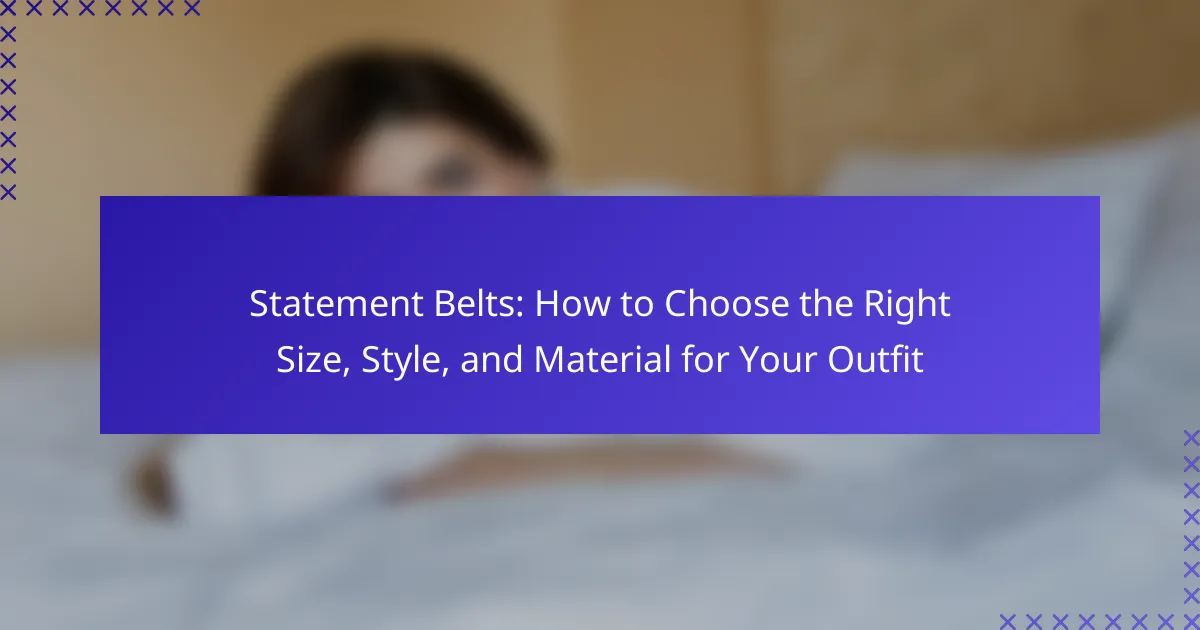Sunglasses are a versatile accessory available in various styles, each catering to distinct aesthetics and functionalities. Key styles include aviators with their teardrop shape and metal frames, Wayfarers featuring thick plastic frames and trapezoidal lenses, and round sunglasses that offer a retro appearance. Cat-eye sunglasses provide a vintage flair with their upswept edges, while oversized sunglasses prioritize maximum coverage. Sports sunglasses are engineered for high performance and durability, and clip-on sunglasses offer convenience by attaching to prescription glasses. This article explores the different frame shapes, lens types, and compatibility with various face shapes to help readers choose the ideal sunglasses.

What are the different styles of sunglasses?
Sunglasses come in various styles, each designed for different aesthetics and functionalities. Popular styles include aviators, which feature a teardrop shape and metal frames. Wayfarers are characterized by their thick plastic frames and trapezoidal lenses. Round sunglasses have circular lenses and are often associated with a retro look. Cat-eye sunglasses feature an upswept outer edge, adding a vintage flair. Oversized sunglasses provide maximum coverage and are often trendy. Sports sunglasses are designed for high performance and durability. Finally, clip-on sunglasses attach to prescription glasses for convenience. Each style serves unique purposes and appeals to different fashion tastes.
How do frame shapes influence sunglasses style?
Frame shapes significantly influence sunglasses style by determining the overall aesthetic and functionality. Different frame shapes, such as round, square, and cat-eye, create distinct looks that appeal to various fashion preferences. For instance, round frames often convey a vintage or bohemian vibe, while square frames can project a modern and edgy appearance. Cat-eye frames are associated with a retro glamour style.
Moreover, the shape of the frame can complement or contrast with face shapes, enhancing individual features. According to the American Academy of Ophthalmology, choosing frames that balance face proportions can improve overall appearance. Thus, frame shapes play a crucial role in defining sunglasses style and personal expression.
What are the most popular frame shapes in sunglasses?
The most popular frame shapes in sunglasses include aviator, wayfarer, round, cat-eye, and rectangular. Aviator frames feature a teardrop shape and are often associated with a classic military style. Wayfarer frames have a trapezoidal shape and are known for their versatility and timeless appeal. Round frames offer a vintage look, appealing to those seeking a retro aesthetic. Cat-eye frames are characterized by their upswept outer edges, providing a bold and fashionable statement. Rectangular frames are sleek and modern, suitable for various face shapes. These shapes are widely recognized in fashion and eyewear markets, contributing to their popularity.
How does frame material affect style and durability?
Frame material significantly influences both the style and durability of sunglasses. Different materials, such as plastic, metal, and acetate, offer unique aesthetic qualities. For instance, metal frames often convey a sleek, modern look, while plastic frames can provide vibrant colors and playful designs. Durability varies by material; metal frames tend to be more robust and resistant to bending, while plastic frames may be lighter but can break more easily under stress. Acetate frames combine style and strength, offering a wide range of colors and patterns while maintaining good durability. Overall, the choice of frame material directly impacts the visual appeal and longevity of sunglasses.
What types of lenses are available for sunglasses?
There are several types of lenses available for sunglasses. Polarized lenses reduce glare from reflective surfaces like water and roads. Photochromic lenses automatically darken in sunlight and lighten indoors. Mirrored lenses have a reflective coating that reduces glare and enhances style. Gradient lenses are darker at the top and gradually lighten toward the bottom. Single vision lenses provide a uniform tint throughout the lens. Multicolor lenses offer various shades for a unique look. Each lens type serves different purposes and enhances visual comfort.
What are the differences between polarized and non-polarized lenses?
Polarized lenses reduce glare from reflective surfaces, while non-polarized lenses do not. Polarized lenses contain a special filter that blocks horizontal light waves. This feature enhances visibility and comfort in bright conditions. Non-polarized lenses simply tint the view without glare reduction. As a result, polarized lenses are ideal for activities like fishing and driving. Studies show that polarized lenses can improve visual clarity and reduce eye strain. Non-polarized lenses may be less expensive but offer limited protection from glare. Therefore, the choice between them depends on specific needs and activities.
How do lens colors impact vision and style?
Lens colors significantly impact both vision and style. Different lens colors enhance contrast and reduce glare in varying environments. For instance, gray lenses offer true color perception and are ideal for bright sunlight. Brown lenses enhance contrast, making them suitable for variable light conditions. Yellow or amber lenses improve depth perception and are often used in low-light situations.
In terms of style, lens color can complement frame color and personal fashion choices. Darker lenses provide a classic look, while colored lenses can add a trendy or playful touch. Additionally, mirrored lenses can create a bold statement. The choice of lens color can reflect personal style and affect how individuals are perceived in social settings.
How does face shape compatibility affect sunglasses selection?
Face shape compatibility significantly influences sunglasses selection. Different face shapes, such as oval, round, square, and heart, have unique characteristics. Sunglasses frames need to complement these features for aesthetic appeal and comfort. For instance, round faces benefit from angular frames to add definition. Conversely, square faces often suit rounded frames to soften their angles.
The right fit enhances not only style but also functionality. Well-chosen sunglasses can improve vision and reduce glare. A study by the American Academy of Ophthalmology emphasizes the importance of proper frame fit for eye protection. Selecting sunglasses based on face shape ensures a balance between fashion and practicality.
What are the main face shapes to consider when choosing sunglasses?
The main face shapes to consider when choosing sunglasses are oval, round, square, heart, and rectangular. Each shape has specific characteristics that influence the best frame styles.
Oval faces are longer than they are wide and have balanced features. Round faces are nearly equal in width and length, with softer angles. Square faces have a strong jawline and equal width across the forehead and cheekbones. Heart-shaped faces are wider at the forehead and taper down to a narrow chin. Rectangular faces are longer than they are wide, with straight sides and a strong jawline.
Choosing the right sunglasses can enhance [censured] symmetry. For example, oval faces can wear most frame shapes. Round faces benefit from angular frames that add definition. Square faces look good in round or oval frames that soften their features. Heart-shaped faces suit frames that are wider at the bottom. Rectangular faces can wear oversized frames to balance their length.
Which frame shapes complement specific face shapes best?
Round frames complement square face shapes best. They soften angular features and create balance. Oval frames suit round face shapes. They add length and create a more defined look. Rectangular frames work well with oval face shapes. They enhance the natural contours. Cat-eye frames are ideal for heart-shaped faces. They draw attention to the eyes and cheekbones. Finally, aviator frames are versatile and can complement various face shapes effectively. These associations are based on principles of symmetry and proportion in [censured] aesthetics.
How can you transition between sunglasses styles effectively?
To transition between sunglasses styles effectively, consider the occasion and outfit compatibility. Choose styles that complement your face shape and personal style. For example, round frames suit square faces, while aviators work well with oval shapes. Gradually introduce new styles by mixing them with familiar ones. Start with neutral colors before experimenting with bold patterns. Pay attention to lens types; polarized lenses reduce glare for outdoor activities. Ensure your sunglasses fit well to maintain comfort and functionality. This approach allows for a seamless transition while keeping your look fresh and stylish.
What factors should you consider when selecting sunglasses for different occasions?
When selecting sunglasses for different occasions, consider the style, lens type, and UV protection. Each occasion may require a different aesthetic. For casual outings, choose trendy frames that match your attire. For sports, opt for wraparound styles that offer secure fit and durability. Lens type affects visibility and comfort. Polarized lenses reduce glare, ideal for water activities. Photochromic lenses adjust to light conditions, suitable for outdoor events. Ensure sunglasses provide adequate UV protection to safeguard your eyes. According to the American Academy of Ophthalmology, UV protection is essential to prevent eye damage.
What are some tips for finding the perfect sunglasses for your face shape?
To find the perfect sunglasses for your face shape, first identify your face shape. Common shapes include oval, round, square, and heart. For oval faces, most frame shapes work well. Round faces benefit from angular frames to add definition. Square faces look great with round or oval frames to soften angles. Heart-shaped faces suit wider frames to balance the forehead. Consider the size of the frames in relation to your face; larger frames complement bigger faces, while smaller frames suit petite features. Ensure the sunglasses sit comfortably on your nose and do not slide down. Finally, choose colors that enhance your skin tone for a cohesive look.
Sunglasses are a vital fashion accessory that come in various styles, including aviators, wayfarers, round, cat-eye, oversized, and sports sunglasses, each serving unique aesthetics and functionalities. The article explores the influence of frame shapes and materials on style and durability, as well as the different types of lenses available, such as polarized and photochromic. Additionally, it examines how face shape compatibility affects sunglasses selection, providing insights on the best frame shapes for various face types. Tips for transitioning between styles and selecting sunglasses for different occasions are also discussed, emphasizing the importance of UV protection.



